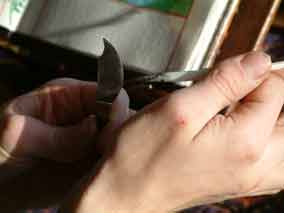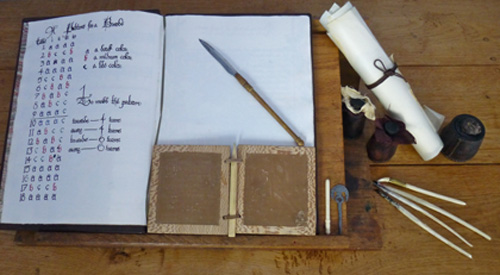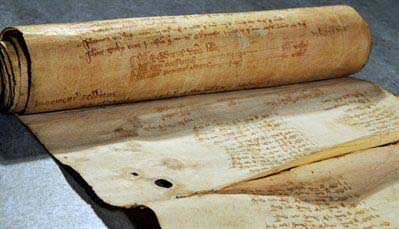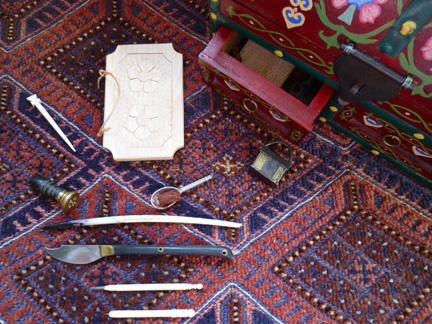| Archery |
| Brewing |
| Calligraphy & writing |
| Combat |
| Cooking |
| Dance |
| Etiquette |
| Household life |
| Medicine |
| Music |
| Needlework |
| Playacting |
| Religion |
| Storytelling |


| Calligraphy and writing represent art
on one hand, necessity on the other. On a mundane level all accounts and
records, orders and receipts had to be kept by hand. In a large household
these documents were very important. Francis, who writes an excellent
“secretary hand” wrote up the daily accounts, inventories
and letters. Since a noble family would have several estates, widely scattered,
it was necessary to keep in regular contact one with another. Francis
took pride in his wonderfully decorated scripts and flourishes for particularly
important documents and made fine drawings and illuminations. Lady Anne
writes to her husband, often away at court, to inform him of all the family
news. She, herself keeps a “Commonplace Book”, for her favourite
poems, recipes, medical advice, an alphabet for teaching the children,
patterns for weaving and anything else she considers useful for reference. |

| Here is a writing slope (all early depictions of writing show a sloping surface being used). A razor sharp penknife lies across the blank page. Below it is a plain wax tablet. Between the leather thongs, Francis has inserted his wooden stylus, pointed for writing at one end, the other cut to a smooth wedge-shape to erase the writing after use. On the edge of the slope beside the book is a bone handled parchment pricker: Its sharp point can pierce several pages at once, marking out where to draw the lines with the lead pencil which stands beside it. Three quill pens rest on the table: notice the feathers have been removed. Sometimes a small tuft of a particular shape was left to identify a pen for its breadth of nib or because it was used for a particular colour of ink. Three leather ink pots, lined with pitch, are seen next to the slope, each containing a different colour: notice how Francis has used colour to clarify the instructions he has written out in Anne’s commonplace book for a tablet-weaving pattern. It is good practice to leave quills steeping in water when waiting to be used. The ivory implement beside the quills holds a smooth dog’s tooth - used for applying gold leaf to illuminated manuscripts. A bundle of parchment sheets is at hand for writing letters. Household accounts were kept on rolls rather than books. The example below dates from c.1430 |

Anne keeps her writing equipment in a
drawer of her painted box. Her wax tablet is small and elaborately carved
and the bone stylus is finely formed. Her lead pencil has a bone handle.
She uses small spoon to melt the sealing wax over a candle flame to prevent
her seal being marred by soot. Her penknife is curved - the pointed end
is useful for cleaning the inside surface of a newly cut quill. Notice
that this table is covered by an imported carpet - another symbol of wealth
and status. |
